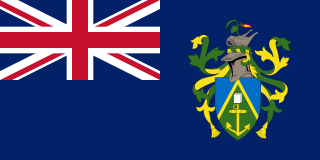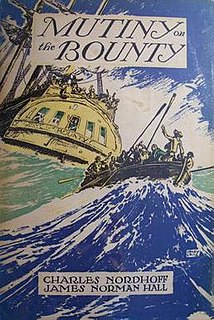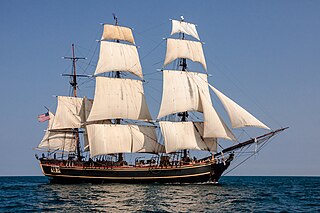
The Pitcairn Islands, officially Pitcairn, Henderson, Ducie and Oeno Islands, are a group of four volcanic islands in the southern Pacific Ocean that form the sole British Overseas Territory in the Pacific Ocean. The four islands—Pitcairn proper, Henderson, Ducie and Oeno—are scattered across several hundred miles of ocean and have a combined land area of about 18 square miles (47 km2). Henderson Island accounts for 86% of the land area, but only Pitcairn Island is inhabited. The nearest places are Mangareva to the west and Easter Island to the east.

Mutiny on the Bounty is the title of the 1932 novel by Charles Nordhoff and James Norman Hall, based on the mutiny against Lieutenant William Bligh, commanding officer of the Bounty in 1789. It has been made into several films and a musical. It was the first of what became The Bounty Trilogy, which continues with Men Against the Sea, and concludes with Pitcairn's Island.

The mutiny on the Royal Navy vessel HMS Bounty occurred in the south Pacific on 28 April 1789. Disaffected crewmen, led by Acting Lieutenant Fletcher Christian, seized control of the ship from their captain, Lieutenant William Bligh, and set him and 18 loyalists adrift in the ship's open launch. The mutineers variously settled on Tahiti or on Pitcairn Island. Bligh meanwhile completed a voyage of more than 3,500 nautical miles in the launch to reach safety, and began the process of bringing the mutineers to justice.

John Adams, known as Jack Adams, was the last survivor of the Bounty mutineers who settled on Pitcairn Island in January 1790, the year after the mutiny. His real name was John Adams, but he used the name Alexander Smith until he was discovered in 1808 by Captain Mayhew Folger of the American whaling ship Topaz. His children used the surname "Adams".

The history of the Pitcairn Islands begins with the colonization of the islands by Polynesians in the 11th century. The Polynesians established a culture that flourished for four centuries and then vanished. They lived on Pitcairn and Henderson Islands, and on Mangareva Island 540 kilometres (340 mi) to the northwest, for about 400 years.

Fletcher Christian was master's mate on board HMS Bounty during Lieutenant William Bligh's voyage to Tahiti during 1787–1789 for breadfruit plants. In the mutiny on the Bounty, Christian seized command of the ship from Bligh on 28 April 1789.
Edward "Ned" Young, was a British sailor, mutineer from the famous HMS Bounty incident, and co-founder of the mutineers' Pitcairn Island settlement.

Peter Heywood was a British naval officer who was on board HMS Bounty during the mutiny of 28 April 1789. He was later captured in Tahiti, tried and condemned to death as a mutineer, but subsequently pardoned. He resumed his naval career and eventually retired with the rank of post-captain, after 29 years of honourable service.

Mutiny on the Bounty is a 1935 Metro-Goldwyn-Mayer drama film directed by Frank Lloyd and starring Charles Laughton and Clark Gable, based on the 1932 Charles Nordhoff and James Norman Hall novel Mutiny on the Bounty.

Mutiny on the Bounty is a 1962 American Technicolor epic historical drama film released by Metro-Goldwyn-Mayer, directed by Lewis Milestone and starring Marlon Brando, Trevor Howard and Richard Harris. The screenplay was written by Charles Lederer, based on the novel Mutiny on the Bounty by Charles Nordhoff and James Norman Hall. Bronisław Kaper composed the score.
The descendants of the Bounty mutineers and their Tahitian consorts include the modern-day Pitcairn Islanders as well as a little less than half of the population of Norfolk Island. Their descendants also live in New Zealand, Australia, and the United States. Because of the scarcity of people on the island, many of the mutineers' children and grandchildren intermarried, with some marrying first and second cousins. Occasionally a new person would arrive on the island bringing with them a new surname.
Pitcairn Islanders, also referred to as Pitkerners and Pitcairnese, are the inhabitants or citizens of the Pitcairn Islands. The Pitcairn Islands are a British Overseas Territory, mainly inhabited by Euronesians of British and Tahitian descent.

Pitcairn's Island is the third installment in the fictional trilogy by Charles Nordhoff and James Norman Hall about the mutiny aboard HMS Bounty. It is preceded by Mutiny on the "Bounty" and Men Against the Sea. The novel first appeared in The Saturday Evening Post then was published in 1934 by Little, Brown and Company. Chapters I–XV are told in the third person, and Chapters XVI–XXI are told in the first person by John Adams. The epilogue that follows is in the third person.
Matthew Quintal was a Cornish able seaman and mutineer aboard HMS Bounty. His surname was, in all probability, the result of misspelling the Cornish surname "Quintrell". He was the last of the mutineers to be murdered on Pitcairn Island. He was murdered or executed by Ned Young and John Adams, leaving them the last two mutineers alive on the island.

HMS Bounty, also known as HM Armed Vessel Bounty, was a small merchant vessel that the Royal Navy purchased for a botanical mission. The ship was sent to the Pacific Ocean under the command of William Bligh to acquire breadfruit plants and transport them to the West Indies. That mission was never completed owing to a mutiny led by acting lieutenant Fletcher Christian. This incident is now popularly known as the mutiny on the Bounty. The mutineers later burned Bounty while she was moored at Pitcairn Island. An American adventurer rediscovered the remains of the Bounty in 1957; various parts of it have been salvaged since then.

Thursday October Christian was the first son of Fletcher Christian and his Tahitian wife Mauatua. He was conceived on Tahiti, and was the first child born on the Pitcairn Islands after the mutineers took refuge on the island. Born on a Thursday in October, he was given his unusual name because Fletcher Christian wanted his son to have "no name that will remind me of England."
George Adams was the only son of the Bounty Mutineer John Adams. He was born to his wife Teio, who had once been the wife of William McCoy and was the mother-in-law of Charles Christian, on Pitcairn Island. Adams was born at a time when all the original mutineers apart from his own father had been killed, or in the case of Ned Young died of natural causes. In 1808 the Pitcairn colony was discovered and the elder Adams was granted amnesty for his part in the mutiny. Both of Adams' parents died in March 1829, when George was 24 years old. Adams served as Chief Magistrate on Pitcairn in 1848. Adams was an opponent of Joshua Hill in the 1830s. Adams opposed the decision to move to Norfolk Island in the 1850s, due to his granddaughter being ill. Adams did eventually move, and died on Norfolk Island in 1873.
The Mutiny of the Bounty is a 1916 Australian-New Zealand silent film directed by Raymond Longford about the mutiny aboard HMS Bounty. It is the first known cinematic dramatisation of this story and is considered a lost film.

The Bounty Bible is a Bible that is thought to have been used on HMS Bounty, the ship famed for the Mutiny on the Bounty.

The complement of HMS Bounty, the Royal Navy ship on which a historic mutiny occurred in the south Pacific on 28 April 1789, comprised 46 men on its departure from England in December 1787 and 44 at the time of the mutiny, including her commander Lieutenant William Bligh. All but two of those aboard were Royal Navy personnel; the exceptions were two civilian botanists engaged to supervise the breadfruit plants Bounty was tasked to take from Tahiti to the West Indies. Of the 44 aboard at the time of the mutiny, 19 were set adrift in the ship's launch, while 25, a mixture of mutineers and detainees, remained on board under Fletcher Christian. Bligh led his loyalists 3,500 nautical miles to safety in the open boat, and ultimately back to England. The mutineers divided—most settled on Tahiti, where they were captured by HMS Pandora in 1791 and returned to England for trial, while Christian and eight others evaded discovery on Pitcairn Island.













